Time Series Analysis of Land Cover Change Using Remotely Sensed and Multisource Urban Data Based on Machine Learning: A Case Study of Shenzhen, China from 1979 to 2022
Abstract
:1. Introduction
2. Data and Methodology
2.1. Study Area and Data
2.2. Classification System
2.3. Method
2.3.1. Land Use Classification
2.3.2. Complex Network of LUCC Progress
2.3.3. Correlation Analysis Using Multisource Urban Data
3. Results
4. Discussions
4.1. Complex Network Analysis on Land Cover Change
4.2. Subsection Traffic Factors in Urban Land Change
4.3. Socioeconomic Factors in Urban Land Change
5. Conclusions
Author Contributions
Funding
Data Availability Statement
Acknowledgments
Conflicts of Interest
References
- Meyer, W.B.; Turner, B.L. Human population growth and global land-use/cover change. Annu. Rev. Ecol. Syst. 1992, 23, 39–61. [Google Scholar] [CrossRef]
- Lambin, E.F.; Geist, H.J. Land-Use and Land-Cover Change: Local Processes and Global Impacts; Springer Science & Business Media: Berlin, Germany, 2008. [Google Scholar]
- Benning, T.L.; LaPointe, D.; Atkinson, C.T.; Vitousek, P.M. Interactions of climate change with biological invasions and land use in the Hawaiian Islands: Modeling the fate of endemic birds using a geographic information system. Proc. Natl. Acad. Sci. USA 2002, 99, 14246–14249. [Google Scholar] [CrossRef] [PubMed] [Green Version]
- Pérez-Vega, A.; Mas, J.-F.; Ligmann-Zielinska, A. Comparing two approaches to land use/cover change modeling and their implications for the assessment of biodiversity loss in a deciduous tropical forest. Environ. Model. Softw. 2012, 29, 11–23. [Google Scholar] [CrossRef]
- Maitima, J.M.; Mugatha, S.M.; Reid, R.S.; Gachimbi, L.N.; Majule, A.; Lyaruu, H.; Pomery, D.; Mathai, S.; Mugisha, S. The linkages between land use change, land degradation and biodiversity across East Africa. Afr. J. Environ. Sci. Technol. 2009, 3, 10. [Google Scholar]
- Titeux, N.; Henle, K.; Mihoub, J.B.; Regos, A.; Geijzendorffer, I.R.; Cramer, W.; Verburg, P.H.; Brotons, L. Biodiversity scenarios neglect future land-use changes. Glob. Chang. Biol. 2016, 22, 2505–2515. [Google Scholar] [CrossRef] [Green Version]
- Reid, R.; Kruska, R.; Muthui, N.; Taye, A.; Wotton, S.; Wilson, C.; Mulatu, W. Land-use and land-cover dynamics in response to changes in climatic, biological and socio-political forces: The case of southwestern Ethiopia. Landsc. Ecol. 2000, 15, 339–355. [Google Scholar] [CrossRef]
- Ureta, C.; Ramírez-Barrón, M.; Sánchez-García, E.A.; Cuervo-Robayo, A.P.; Munguía-Carrara, M.; Mendoza-Ponce, A.; Gay, C.; Sánchez-Cordero, V. Species, taxonomic, and functional group diversities of terrestrial mammals at risk under climate change and land-use/cover change scenarios in Mexico. Glob. Chang. Biol. 2022, 28, 6992–7008. [Google Scholar] [CrossRef]
- Li, X.; Zou, L.; Xia, J.; Dou, M. Untangling the effects of climate change and land use/cover change on spatiotemporal variation of evapotranspiration over China. J. Hydrol. 2022, 612, 128189. [Google Scholar] [CrossRef]
- Riebsame, W.E.; Meyer, W.B.; Turner, B. Modeling land use and cover as part of global environmental change. Clim. Chang. 1994, 28, 45–64. [Google Scholar] [CrossRef]
- Liu, Y.; Huang, X.; Yang, H.; Zhong, T. Environmental effects of land-use/cover change caused by urbanization and policies in Southwest China Karst area–A case study of Guiyang. Habitat Int. 2014, 44, 339–348. [Google Scholar] [CrossRef]
- Kreuter, U.P.; Harris, H.G.; Matlock, M.D.; Lacey, R.E. Change in ecosystem service values in the San Antonio area, Texas. Ecol. Econ. 2001, 39, 333–346. [Google Scholar] [CrossRef]
- Wang, P.; Yu, P.; Lu, J.; Zhang, Y. The mediation effect of land surface temperature in the relationship between land use-cover change and energy consumption under seasonal variations. J. Clean. Prod. 2022, 340, 130804. [Google Scholar] [CrossRef]
- Moarrab, Y.; Salehi, E.; Amiri, M.; Hovidi, H. Spatial–temporal assessment and modeling of ecological security based on land-use/cover changes (case study: Lavasanat watershed). Int. J. Environ. Sci. Technol. 2022, 19, 3991–4006. [Google Scholar] [CrossRef]
- Duran, E.; Mas, J.-F.; Velázquez, A. Land use/cover change in community-based forest management regions and protected areas in Mexico. In The Community Forests of México; University of Texas Press: Austin, TX, USA, 2021; pp. 215–238. [Google Scholar]
- Flamenco-Sandoval, A.; Ramos, M.M.; Masera, O.R. Assessing implications of land-use and land-cover change dynamics for conservation of a highly diverse tropical rain forest. Biol. Conserv. 2007, 138, 131–145. [Google Scholar] [CrossRef]
- Geist, H.J. The Land-Use and Cover-Change (LUCC) ProjectGeist. The land-use and cover-change (lucc) project. In Land Use, Land Cover and Soil Sciences-Volume I: Land Cover, Land Use and the Global Change; University of Louvain: Ottignies-Louvain-la-Neuve, Belgium, 2009; p. 209. [Google Scholar]
- He, C.; Zhang, J.; Liu, Z.; Huang, Q. Characteristics and progress of land use/cover change research during 1990–2018. J. Geogr. Sci. 2022, 32, 537–559. [Google Scholar] [CrossRef]
- Chhabra, A.; Geist, H.; Houghton, R.A.; Haberl, H.; Braimoh, A.K.; Vlek, P.L.; Patz, J.; Xu, J.; Ramankutty, N.; Coomes, O. Multiple impacts of land-use/cover change. In Land-Use and Land-Cover Change; Springer: Berlin/Heidelberg, Germany, 2006; pp. 71–116. [Google Scholar]
- Kanianska, R.; Kizeková, M.; Nováček, J.; Zeman, M. Land-use and land-cover changes in rural areas during different political systems: A case study of Slovakia from 1782 to 2006. Land Use Policy 2014, 36, 554–566. [Google Scholar] [CrossRef]
- He, X.; Liang, J.; Zeng, G.; Yuan, Y.; Li, X. The effects of interaction between climate change and land-use/cover change on biodiversity-related ecosystem services. Glob. Chall. 2019, 3, 1800095. [Google Scholar] [CrossRef] [Green Version]
- Delgado-Artés, R.; Garófano-Gómez, V.; Oliver-Villanueva, J.-V.; Rojas-Briales, E. Land use/cover change analysis in the Mediterranean region: A regional case study of forest evolution in Castelló (Spain) over 50 years. Land Use Policy 2022, 114, 105967. [Google Scholar] [CrossRef]
- Geist, H.; McConnell, W.; Lambin, E.F.; Moran, E.; Alves, D.; Rudel, T. Causes and trajectories of land-use/cover change. In Land-Use and Land-Cover Change; Springer: Berlin/Heidelberg, Germany, 2006; pp. 41–70. [Google Scholar]
- Li, Y. Urban–rural interaction patterns and dynamic land use: Implications for urban–rural integration in China. Reg. Environ. Chang. 2012, 12, 803–812. [Google Scholar] [CrossRef]
- Long, H.; Wu, X.; Wang, W.; Dong, G. Analysis of urban-rural land-use change during 1995-2006 and its policy dimensional driving forces in Chongqing, China. Sensors 2008, 8, 681–699. [Google Scholar] [CrossRef] [Green Version]
- König, H.J.; Schuler, J.; Suarma, U.; McNeill, D.; Imbernon, J.; Damayanti, F.; Dalimunthe, S.A.; Uthes, S.; Sartohadi, J.; Helming, K. Assessing the impact of land use policy on urban-rural sustainability using the FoPIA approach in Yogyakarta, Indonesia. Sustainability 2010, 2, 1991–2009. [Google Scholar] [CrossRef]
- Verburg, P.H.; Kok, K.; Pontius, R.G.; Veldkamp, A. Modeling land-use and land-cover change. In Land-Use and Land-Cover Change; Springer: Berlin/Heidelberg, Germany, 2006; pp. 117–135. [Google Scholar]
- Riebsame, W.; Parton, W.; Galvin, K.; Burke, I.; Bohren, L.; Young, R.; Knop, E. Integrated modeling of land use and cover change. Bioscience 1994, 44, 350–356. [Google Scholar] [CrossRef]
- Bao, S.; Yang, F. Spatio-Temporal Dynamic of the Land Use/Cover Change and Scenario Simulation in the Southeast Coastal Shelterbelt System Construction Project Region of China. Sustainability 2022, 14, 8952. [Google Scholar] [CrossRef]
- Wang, J.; Li, Y.; Wang, Q.; Cheong, K.C. Urban–rural construction land replacement for more sustainable land use and regional development in China: Policies and practices. Land 2019, 8, 171. [Google Scholar] [CrossRef] [Green Version]
- He, H.; Hamdi, R.; Cai, P.; Luo, G.; Ochege, F.U.; Zhang, M.; Termonia, P.; De Maeyer, P.; Li, C. Impacts of historical land use/cover change (1980–2015) on summer climate in the Aral Sea region. J. Geophys. Res. Atmos. 2021, 126, e2020JD032638. [Google Scholar] [CrossRef]
- Zhang, B.; Zhou, W. Spatial–temporal characteristics of precipitation and its relationship with land use/cover change on the Qinghai-Tibet Plateau, China. Land 2021, 10, 269. [Google Scholar] [CrossRef]
- Castella, J.-C.; Kam, S.P.; Quang, D.D.; Verburg, P.H.; Hoanh, C.T. Combining top-down and bottom-up modelling approaches of land use/cover change to support public policies: Application to sustainable management of natural resources in northern Vietnam. Land Use Policy 2007, 24, 531–545. [Google Scholar] [CrossRef]
- Munroe, D.K.; Müller, D. Issues in spatially explicit statistical land-use/cover change (LUCC) models: Examples from western Honduras and the Central Highlands of Vietnam. Land Use Policy 2007, 24, 521–530. [Google Scholar] [CrossRef]
- Li, Z.; Ren, Y.; Li, J.; Li, Y.; Rykov, P.; Chen, F.; Zhang, W. Land-use/cover change and driving mechanism on the west bank of lake Baikal from 2005 to 2015—A case study of Irkutsk city. Sustainability 2018, 10, 2904. [Google Scholar] [CrossRef] [Green Version]
- Ntukey, L.T.; Munishi, L.K.; Treydte, A.C. Land Use Land/Cover Change Reduces Woody Plant Diversity and Carbon Stocks in a Lowland Coastal Forest Ecosystem, Tanzania. Sustainability 2022, 14, 8551. [Google Scholar] [CrossRef]
- Parker, D.C.; Manson, S.M.; Janssen, M.A.; Hoffmann, M.J.; Deadman, P. Multi-agent systems for the simulation of land-use and land-cover change: A review. Ann. Assoc. Am. Geogr. 2003, 93, 314–337. [Google Scholar] [CrossRef]
- Moran, E.F. News on the land project. Glob. Chang. Newslett 2003, 54, 19–21. [Google Scholar]
- Liu, Y.; Luo, T.; Liu, Z.; Kong, X.; Li, J.; Tan, R. A comparative analysis of urban and rural construction land use change and driving forces: Implications for urban–rural coordination development in Wuhan, Central China. Habitat Int. 2015, 47, 113–125. [Google Scholar] [CrossRef]
- Liaqat, M.U.; Mohamed, M.M.; Chowdhury, R.; Elmahdy, S.I.; Khan, Q.; Ansari, R. Impact of land use/land cover changes on groundwater resources in Al Ain region of the United Arab Emirates using remote sensing and GIS techniques. Groundw. Sustain. Dev. 2021, 14, 100587. [Google Scholar] [CrossRef]
- Turner, B.L.; Meyer, W.B.; Skole, D.L. Global land-use/land-cover change: Towards an integrated study. AMBIO 1994, 23, 91–95. [Google Scholar]
- Kabeja, C.; Li, R.; Rwabuhungu Rwatangabo, D.E.; Duan, J. Monitoring Land Use/Cover Changes by Using Multi-Temporal Remote Sensing for Urban Hydrological Assessment: A Case Study in Beijing, China. Remote Sens. 2022, 14, 4273. [Google Scholar] [CrossRef]
- Rawat, J.; Kumar, M. Monitoring land use/cover change using remote sensing and GIS techniques: A case study of Hawalbagh block, district Almora, Uttarakhand, India. Egypt. J. Remote Sens. Space Sci. 2015, 18, 77–84. [Google Scholar] [CrossRef] [Green Version]
- Mundia, C.N.; Aniya, M. Analysis of land use/cover changes and urban expansion of Nairobi city using remote sensing and GIS. Int. J. Remote Sens. 2005, 26, 2831–2849. [Google Scholar] [CrossRef]
- Guo, L.; Xi, X.; Yang, W.; Liang, L. Monitoring Land Use/Cover Change Using Remotely Sensed Data in Guangzhou of China. Sustainability 2021, 13, 2944. [Google Scholar] [CrossRef]
- Liang, J.; Chen, C.; Sun, H.; Zhang, Z. Analysis on Land-Use/Cover Change in Hangzhou Bay, China during 2000–2020 Using the Google Earth Engine. In Proceedings of the 2022 3rd International Conference on Geology, Mapping and Remote Sensing (ICGMRS), Zhoushan, China, 22–24 April 2022; pp. 546–549. [Google Scholar]
- Dewan, A.M.; Yamaguchi, Y. Using remote sensing and GIS to detect and monitor land use and land cover change in Dhaka Metropolitan of Bangladesh during 1960–2005. Environ. Monit. Assess. 2009, 150, 237–249. [Google Scholar] [CrossRef]
- Yin, J.; Yin, Z.; Zhong, H.; Xu, S.; Hu, X.; Wang, J.; Wu, J. Monitoring urban expansion and land use/land cover changes of Shanghai metropolitan area during the transitional economy (1979–2009) in China. Environ. Monit. Assess. 2011, 177, 609–621. [Google Scholar] [CrossRef] [PubMed]
- Zhao, L.; Huang, W.; Chen, J.; Dong, Y.; Ren, B.; Geng, Y. Land use/cover changes in the Oriental migratory locust area of China: Implications for ecological control and monitoring of locust area. Agric. Ecosyst. Environ. 2020, 303, 107110. [Google Scholar] [CrossRef]
- Deng, X.; Li, Z. A review on historical trajectories and spatially explicit scenarios of land-use and land-cover changes in China. J. Land Use Sci. 2016, 11, 709–724. [Google Scholar] [CrossRef]
- Lambin, E.F.; Turner, B.L.; Geist, H.J.; Agbola, S.B.; Angelsen, A.; Bruce, J.W.; Coomes, O.T.; Dirzo, R.; Fischer, G.; Folke, C. The causes of land-use and land-cover change: Moving beyond the myths. Glob. Environ. Chang. 2001, 11, 261–269. [Google Scholar] [CrossRef]
- Yubo, Z.; Zhuoran, Y.; Jiuchun, Y.; Yuanyuan, Y.; Dongyan, W.; Yucong, Z.; Fengqin, Y.; Lingxue, Y.; Liping, C.; Shuwen, Z. A novel model integrating deep learning for land use/cover change reconstruction: A case study of zhenlai county, northeast China. Remote Sens. 2020, 12, 3314. [Google Scholar] [CrossRef]
- Schaldach, R.; Alcamo, J.; Koch, J.; Kolking, C.; Lapola, D.M.; Schungel, J.; Priess, J.A. An integrated approach to modelling land-use change on continental and global scales. Environ. Model. Softw. 2011, 26, 1041–1051. [Google Scholar] [CrossRef]
- Yu, W.; Zang, S.; Wu, C.; Liu, W.; Na, X. Analyzing and modeling land use land cover change (LUCC) in the Daqing City, China. Appl. Geogr. 2011, 31, 600–608. [Google Scholar] [CrossRef]
- Mas, J.-F.; Kolb, M.; Paegelow, M.; Olmedo, M.T.C.; Houet, T. Inductive pattern-based land use/cover change models: A comparison of four software packages. Environ. Model. Softw. 2014, 51, 94–111. [Google Scholar] [CrossRef] [Green Version]
- Azizi, P.; Soltani, A.; Bagheri, F.; Sharifi, S.; Mikaeili, M. An Integrated Modelling Approach to Urban Growth and Land Use/Cover Change. Land 2022, 11, 1715. [Google Scholar] [CrossRef]
- Seto, K.C.; Kaufmann, R.K. Modeling the drivers of urban land use change in the Pearl River Delta, China: Integrating remote sensing with socioeconomic data. Land Econ. 2003, 79, 106–121. [Google Scholar] [CrossRef] [Green Version]
- Edan, M.H.; Maarouf, R.M.; Hasson, J. Predicting the impacts of land use/land cover change on land surface temperature using remote sensing approach in Al Kut, Iraq. Phys. Chem. Earth Parts A/B/C 2021, 123, 103012. [Google Scholar] [CrossRef]
- Zhang, Y.; Yang, J.; Wang, D.; Wang, J.; Yu, L.; Yan, F.; Chang, L.; Zhang, S. An Integrated CNN Model for Reconstructing and Predicting Land Use/Cover Change: A Case Study of the Baicheng Area, Northeast China. Remote Sens. 2021, 13, 4846. [Google Scholar] [CrossRef]
- Zhang, F.; Yushanjiang, A.; Jing, Y. Assessing and predicting changes of the ecosystem service values based on land use/cover change in Ebinur Lake Wetland National Nature Reserve, Xinjiang, China. Sci. Total Environ. 2019, 656, 1133–1144. [Google Scholar] [CrossRef] [PubMed]
- Stych, P.; Kabrda, J.; Bicik, I.; Lastovicka, J. Regional differentiation of long-term land use changes: A case study of Czechia. Land 2019, 8, 165. [Google Scholar] [CrossRef] [Green Version]
- Zhang, B.; Yin, L.; Zhang, S.; Feng, C. Assessment on characteristics of LUCC process based on complex network in Modern Yellow River Delta, Shandong Province of China. Earth Sci. Inform. 2016, 9, 83–93. [Google Scholar] [CrossRef]
- Qian, J.; Peng, Y.; Luo, C.; Wu, C.; Du, Q. Urban land expansion and sustainable land use policy in Shenzhen: A case study of China’s rapid urbanization. Sustainability 2015, 8, 16. [Google Scholar] [CrossRef] [Green Version]
- Shi, P.; Yu, D. Assessing urban environmental resources and services of Shenzhen, China: A landscape-based approach for urban planning and sustainability. Landsc. Urban Plan. 2014, 125, 290–297. [Google Scholar] [CrossRef]
- Peng, Y.; Yang, F.; Zhu, L.; Li, R.; Wu, C.; Chen, D. Comparative Analysis of the Factors Influencing Land Use Change for Emerging Industry and Traditional Industry: A Case Study of Shenzhen City, China. Land 2021, 10, 575. [Google Scholar] [CrossRef]
- Seto, K.C.; Fragkias, M. Quantifying spatiotemporal patterns of urban land-use change in four cities of China with time series landscape metrics. Landsc. Ecol. 2005, 20, 871–888. [Google Scholar] [CrossRef]
- Ding, K.; Wang, C.; Tao, M.; Xiao, H.; Yang, C.; Huang, P. A Classification Method of Land Cover Based on Support Vector Machines. In Proceedings of the International Conference on Machine Learning for Cyber Security, Guangzhou, China, 8–10 October 2020; pp. 48–54. [Google Scholar]
- Liu, W.; Meng, Q.; Allam, M.; Zhang, L.; Hu, D.; Menenti, M. Driving factors of land surface temperature in urban agglomerations: A case study in the pearl river delta, china. Remote Sens. 2021, 13, 2858. [Google Scholar] [CrossRef]
- Li, T.; Li, W. Multiple land use change simulation with Monte Carlo approach and CA-ANN model, a case study in Shenzhen, China. Environ. Syst. Res. 2015, 4, 1. [Google Scholar] [CrossRef] [Green Version]
- Sui, D.Z.; Zeng, H. Modeling the dynamics of landscape structure in Asia’s emerging desakota regions: A case study in Shenzhen. Landsc. Urban Plan. 2001, 53, 37–52. [Google Scholar] [CrossRef]
- Li, X.; Yeh, A.G.-O. Analyzing spatial restructuring of land use patterns in a fast growing region using remote sensing and GIS. Landsc. Urban Plan. 2004, 69, 335–354. [Google Scholar] [CrossRef]
- Wang, H.; Li, B.; Yi, T.; Wu, J. Heterogeneous Urban Thermal Contribution of Functional Construction Land Zones: A Case Study in Shenzhen, China. Remote Sens. 2022, 14, 1851. [Google Scholar] [CrossRef]
- YANG, M.; GUO, R.; LI, Q. Construction Land Change Driving Forces in Rapid Urbanization Area: A Case Study of Longgang District of Shenzhen City. Geomat. Inf. Sci. Wuhan Univ. 2009, 34, 170–173. [Google Scholar]
- Sun, S.; Mu, L.; Feng, R.; Wang, L.; He, J. GAN-Based LUCC Prediction via the Combination of Prior City Planning Information and Land-Use Probability. IEEE J. Sel. Top. Appl. Earth Obs. Remote Sens. 2021, 14, 10189–10198. [Google Scholar] [CrossRef]
- Yang, Q.; Li, X.; Shi, X. Cellular automata for simulating land use changes based on support vector machines. Comput. Geosci. 2008, 34, 592–602. [Google Scholar] [CrossRef]
- Fan, W.; Fong, D.K.C.; Li, G.; Law, R. Understanding clusters of tourist behavior associations using network analysis. Int. J. Hosp. Tour. Adm. 2021, 22, 502–523. [Google Scholar] [CrossRef]
- Wang, Z.; Li, T.; Yang, S.; Zhong, D. Spatio-Temporal Dynamic and Structural Characteristics of Land Use/Cover Change Based on a Complex Network: A Case Study of the Middle Reaches of Yangtze River Urban Agglomeration. Sustainability 2022, 14, 6941. [Google Scholar] [CrossRef]
- Klerkx, L.; Aarts, N.; Leeuwis, C. Adaptive management in agricultural innovation systems: The interactions between innovation networks and their environment. Agric. Syst. 2010, 103, 390–400. [Google Scholar] [CrossRef]
- Zhang, M.; Wang, J.; Feng, Y. Temporal and spatial change of land use in a large-scale opencast coal mine area: A complex network approach. Land Use Policy 2019, 86, 375–386. [Google Scholar] [CrossRef]
- Pan, W.; Du, J. Towards sustainable urban transition: A critical review of strategies and policies of urban village renewal in Shenzhen, China. Land Use Policy 2021, 111, 105744. [Google Scholar] [CrossRef]
- Yu, W.; Zhang, Y.; Zhou, W.; Wang, W.; Tang, R. Urban expansion in Shenzhen since 1970s: A retrospect of change from a village to a megacity from the space. Phys. Chem. Earth Parts A/B/C 2019, 110, 21–30. [Google Scholar] [CrossRef]
- Shenzhen Statistical Yearbook Data from Statistics Bureau of Shenzhen Municipality Website. Available online: Tjj.sz.gov.cn/zwgk/zfxxgkml/tjsj/tjnj/index.html (accessed on 16 September 2022).
- USGS. Available online: Earthexplorer.usgs.gov (accessed on 6 October 2022).
- Zhang, Z.; Wang, X.; Zhao, X.; Liu, B.; Yi, L.; Zuo, L.; Wen, Q.; Liu, F.; Xu, J.; Hu, S. A 2010 update of National Land Use/Cover Database of China at 1: 100000 scale using medium spatial resolution satellite images. Remote Sens. Environ. 2014, 149, 142–154. [Google Scholar] [CrossRef]
- Wu, B.-L.; Sun, H.; Shi, J.-N.; Zhang, Y.-T.; Shi, L.-J. Dynamic change and prediction of vegetation cover in Shenzhen, China from 2000 to 2018. J. Appl. Ecol. 2020, 31, 3777–3785. [Google Scholar]
- Nordkvist, K.; Granholm, A.-H.; Holmgren, J.; Olsson, H.; Nilsson, M. Combining optical satellite data and airborne laser scanner data for vegetation classification. Remote Sens. Lett. 2011, 3, 393–401. [Google Scholar] [CrossRef] [Green Version]
- Friedl, M.A.; Brodley, C.E. Decision tree classification of land cover from remotely sensed data. Remote Sens. Environ. 1997, 61, 399–409. [Google Scholar] [CrossRef]
- Franco-Lopez, H.; Ek, A.R.; Bauer, M.E. Estimation and mapping of forest stand density, volume, and cover type using the k-nearest neighbors method. Remote Sens. Environ. 2001, 77, 251–274. [Google Scholar] [CrossRef]
- Wang, C.; Wang, X.-S.; Xu, Y.; Zhang, B.; Jiang, M.; Xiong, S.; Zhang, Q.; Li, W.; Li, Q. A new likelihood function for consistent phase series estimation in distributed scatterer interferometry. IEEE Trans. Geosci. Remote Sens. 2022, 60, 1–14. [Google Scholar] [CrossRef]
- Yanfei, Z.; Liangpei, Z. An Adaptive Artificial Immune Network for Supervised Classification of Multi-/Hyperspectral Remote Sensing Imagery. Geosci. Remote Sens. IEEE Trans. 2012, 50, 894–909. [Google Scholar] [CrossRef]
- Mountrakis, G.; Im, J.; Ogole, C. Support vector machines in remote sensing: A review. ISPRS J. Photogramm. Remote Sens. 2011, 66, 247–259. [Google Scholar] [CrossRef]
- Pal, M.; Mather, P. Support vector machines for classification in remote sensing. Int. J. Remote Sens. 2005, 26, 1007–1011. [Google Scholar] [CrossRef]
- Kavzoglu, T.; Colkesen, I. A kernel functions analysis for support vector machines for land cover classification. Int. J. Appl. Earth Obs. Geoinf. 2009, 11, 352–359. [Google Scholar] [CrossRef]
- Karan, S.K.; Samadder, S.R. A comparison of different land-use classification techniques for accurate monitoring of degraded coal-mining areas. Environ. Earth Sci. 2018, 77, 713. [Google Scholar] [CrossRef]
- Hong, H.; Pradhan, B.; Bui, D.T.; Xu, C.; Youssef, A.M.; Chen, W. Comparison of four kernel functions used in support vector machines for landslide susceptibility mapping: A case study at Suichuan area (China). Geomat. Nat. Hazards Risk 2017, 8, 544–569. [Google Scholar] [CrossRef]
- Che, J.; Wang, J. Short-term load forecasting using a kernel-based support vector regression combination model. Appl. Energy 2014, 132, 602–609. [Google Scholar] [CrossRef]
- Hamad, S.I. Data Classification with Support Vector Machine Kernel Function. Eurasian J. Eng. Technol. 2022, 4, 89–95. [Google Scholar]
- Boccaletti, S.; Latora, V.; Moreno, Y.; Chavez, M.; Hwang, D.-U. Complex networks: Structure and dynamics. Phys. Rep. 2006, 424, 175–308. [Google Scholar] [CrossRef]
- Pengfei, W.; Huili, G.; Demin, Z. Land Use and Land Cover Change in Watershed of Guanting Reservoir Based on Complex Network. Acta Geogr. Sin. 2012, 67, 113–121. [Google Scholar] [CrossRef]
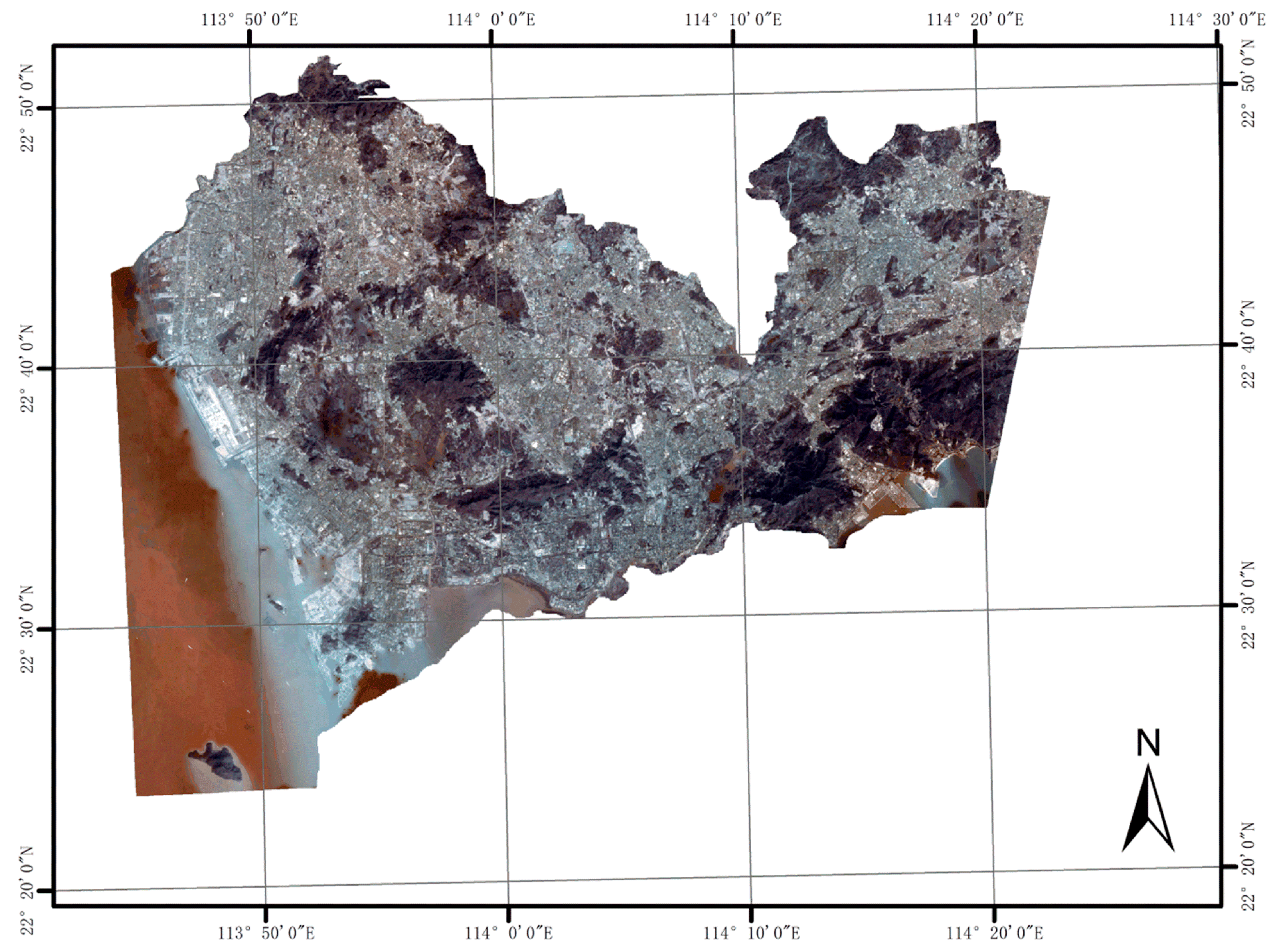
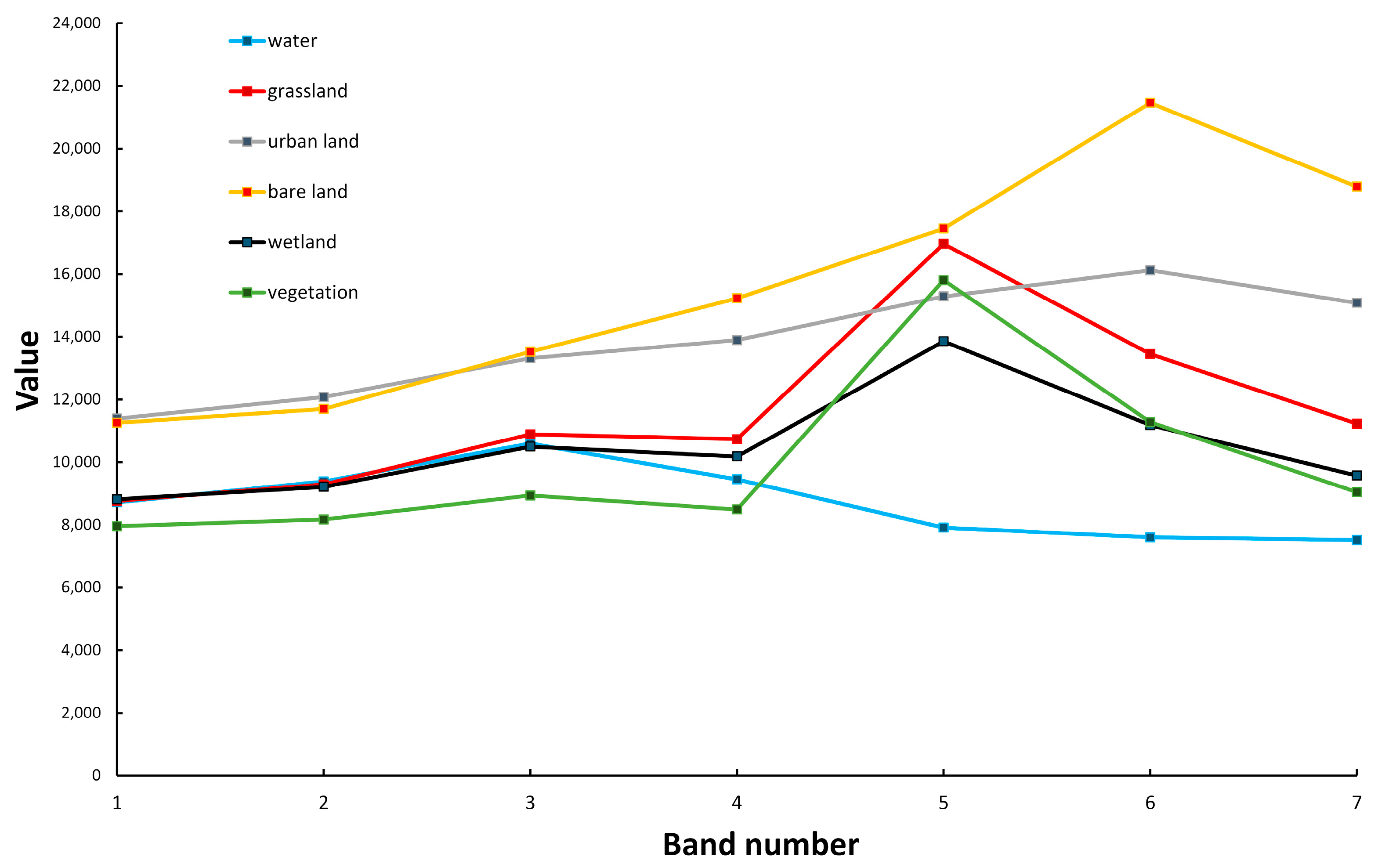


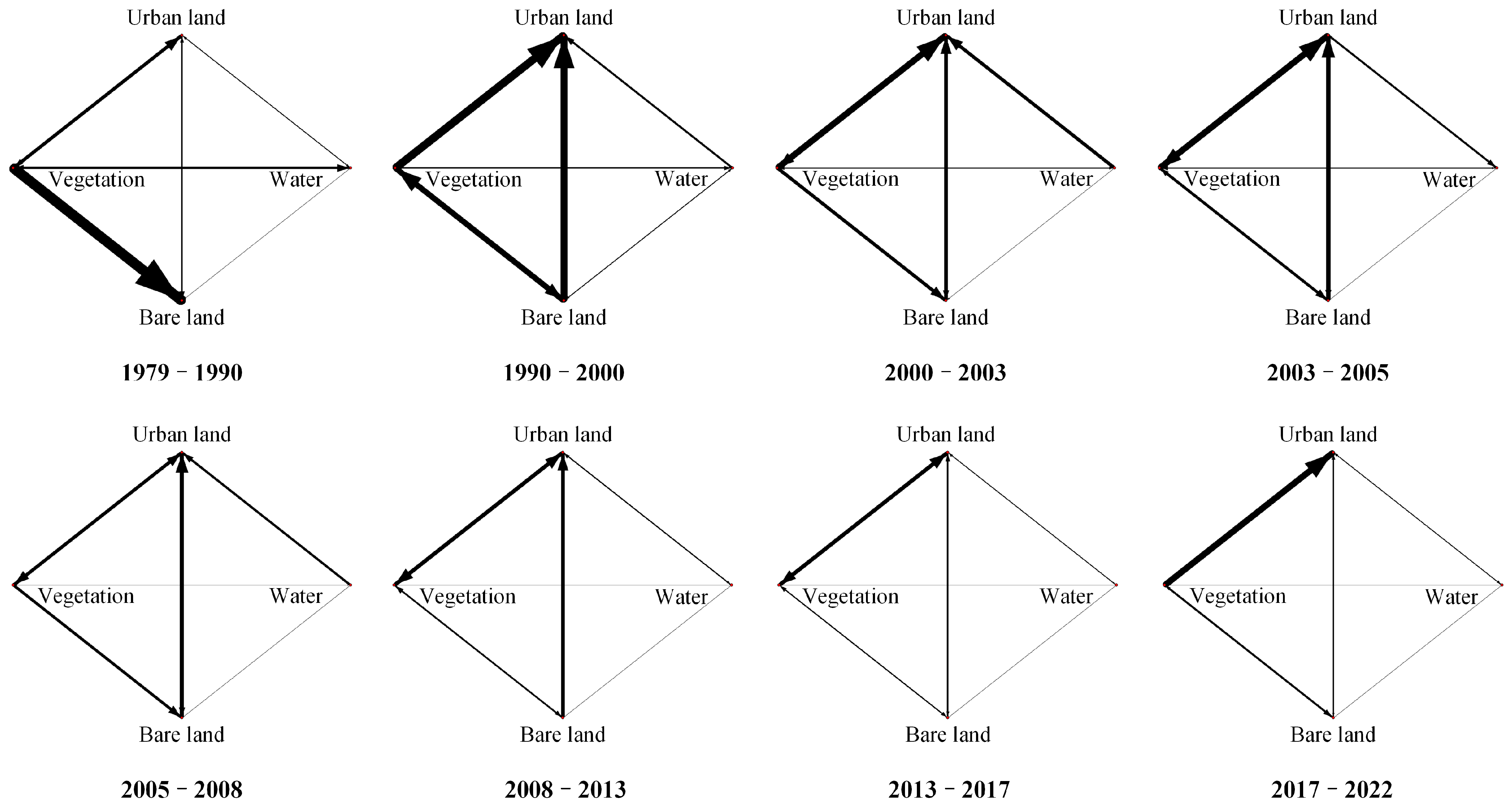

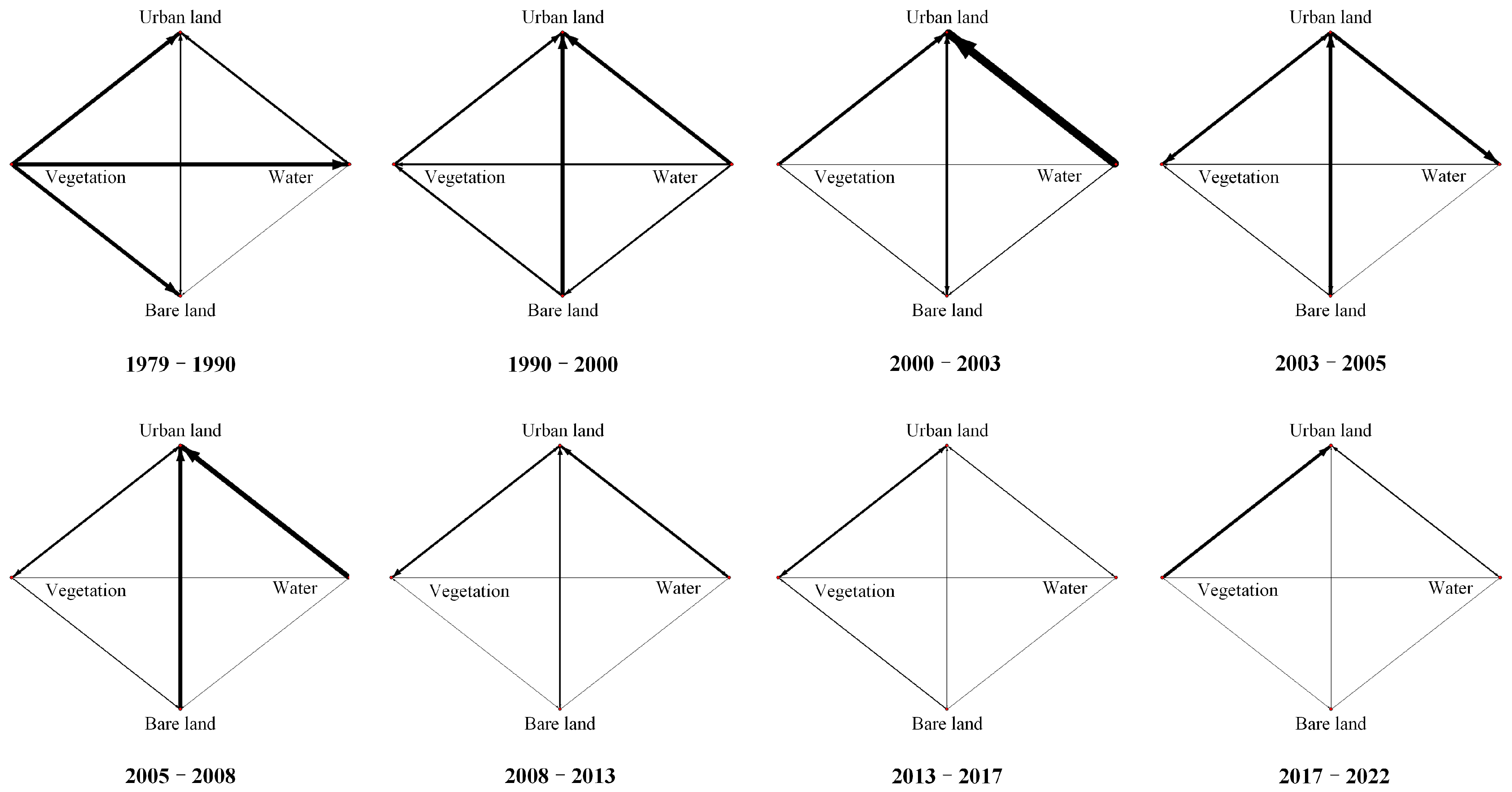
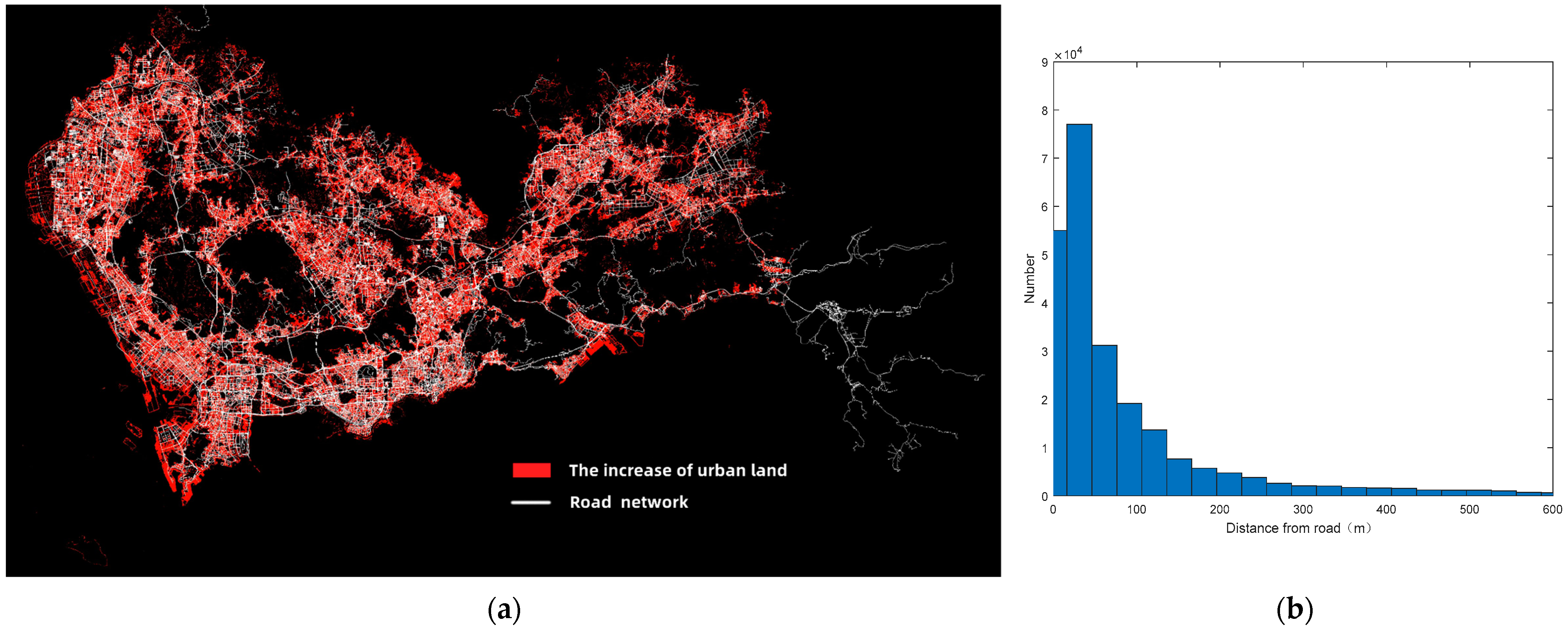

| Date | Image Type | Resolution | Bands | Wavelength | Orbit | Frame |
|---|---|---|---|---|---|---|
| 1979-10-13 | MSS | 60 m | 4 | 0.5–1.1 μm | 131 | 044 |
| 1990-10-13 | TM | 30 m | 7 | 0.45–2.35 μm | 122 | 044 |
| 2000-09-14 | ETM+ | 30 m | 8 | 0.45–2.35 μm | 122 | 044 |
| 2003-01-10 | ETM+ | 30 m | 8 | 0.45–2.35 μm | 122 | 044 |
| 2005-11-23 | TM | 30 m | 7 | 0.45–2.35 μm | 122 | 044 |
| 2008-12-17 | TM | 30 m | 7 | 0.45–2.35 μm | 122 | 044 |
| 2013-12-31 | OLI | 30 m | 11 | 0.42–12.51 μm | 122 | 044 |
| 2017-10-23 | OLI | 30 m | 11 | 0.42–12.51 μm | 122 | 044 |
| 2022-01-06 | OLI | 30 m | 11 | 0.42–12.51 μm | 122 | 044 |
| Time | Vegetation | Urban Land | Water | Bare Land | ||||||||
|---|---|---|---|---|---|---|---|---|---|---|---|---|
| Total (km2) | Rate (km2/Year) | Rate (%) | Total (km2) | Rate (km2/Year) | Rate (%) | Total (km2) | Rate (km2/Year) | Rate (%) | Total (km2) | Rate (km2/Year) | Rate (%) | |
| 1979 | 1131.36 | 101.82 | 543.88 | 129.91 | ||||||||
| 1990 | 956.04 | −15.94 | −15.50 | 124.71 | 2.08 | 22.49 | 547.09 | 0.29 | 0.59 | 279.13 | 13.57 | 114.86 |
| 2000 | 834.54 | −12.15 | −12.71 | 419.24 | 29.45 | 236.16 | 521.62 | −2.55 | −4.66 | 131.57 | −14.76 | −52.86 |
| 2003 | 749.50 | −36.50 | −10.19 | 565.91 | 62.95 | 34.99 | 451.11 | −30.26 | −13.52 | 140.45 | 3.81 | 6.75 |
| 2005 | 716.50 | −11.66 | −4.40 | 608.34 | 14.99 | 7.50 | 464.13 | 4.60 | 2.89 | 118.00 | −7.93 | −15.98 |
| 2008 | 681.08 | −11.81 | −4.94 | 684.62 | 25.43 | 12.54 | 421.41 | −14.24 | −9.20 | 119.85 | 0.62 | 1.57 |
| 2013 | 692.64 | 2.31 | 1.70 | 744.07 | 11.89 | 8.68 | 410.88 | −2.11 | −2.50 | 59.38 | −12.09 | −50.45 |
| 2017 | 686.80 | −1.54 | −0.84 | 767.09 | 6.06 | 3.09 | 407.71 | −0.83 | −0.77 | 45.37 | −3.69 | −23.61 |
| 2022 | 585.09 | −24.22 | −14.81 | 858.66 | 21.80 | 11.94 | 410.93 | 0.77 | 0.79 | 52.29 | 1.65 | 15.27 |
Publisher’s Note: MDPI stays neutral with regard to jurisdictional claims in published maps and institutional affiliations. |
© 2022 by the authors. Licensee MDPI, Basel, Switzerland. This article is an open access article distributed under the terms and conditions of the Creative Commons Attribution (CC BY) license (https://creativecommons.org/licenses/by/4.0/).
Share and Cite
Ding, K.; Huang, Y.; Wang, C.; Li, Q.; Yang, C.; Fang, X.; Tao, M.; Xie, R.; Dai, M. Time Series Analysis of Land Cover Change Using Remotely Sensed and Multisource Urban Data Based on Machine Learning: A Case Study of Shenzhen, China from 1979 to 2022. Remote Sens. 2022, 14, 5706. https://doi.org/10.3390/rs14225706
Ding K, Huang Y, Wang C, Li Q, Yang C, Fang X, Tao M, Xie R, Dai M. Time Series Analysis of Land Cover Change Using Remotely Sensed and Multisource Urban Data Based on Machine Learning: A Case Study of Shenzhen, China from 1979 to 2022. Remote Sensing. 2022; 14(22):5706. https://doi.org/10.3390/rs14225706
Chicago/Turabian StyleDing, Kai, Yidu Huang, Chisheng Wang, Qingquan Li, Chao Yang, Xu Fang, Ming Tao, Renping Xie, and Ming Dai. 2022. "Time Series Analysis of Land Cover Change Using Remotely Sensed and Multisource Urban Data Based on Machine Learning: A Case Study of Shenzhen, China from 1979 to 2022" Remote Sensing 14, no. 22: 5706. https://doi.org/10.3390/rs14225706






